How to design a potager garden for vegetables and flowers
Our expert tips on how to design a potager garden will help you create a plot that’s filled with blooms, attractive edibles, is great for pollinators and easy to maintain
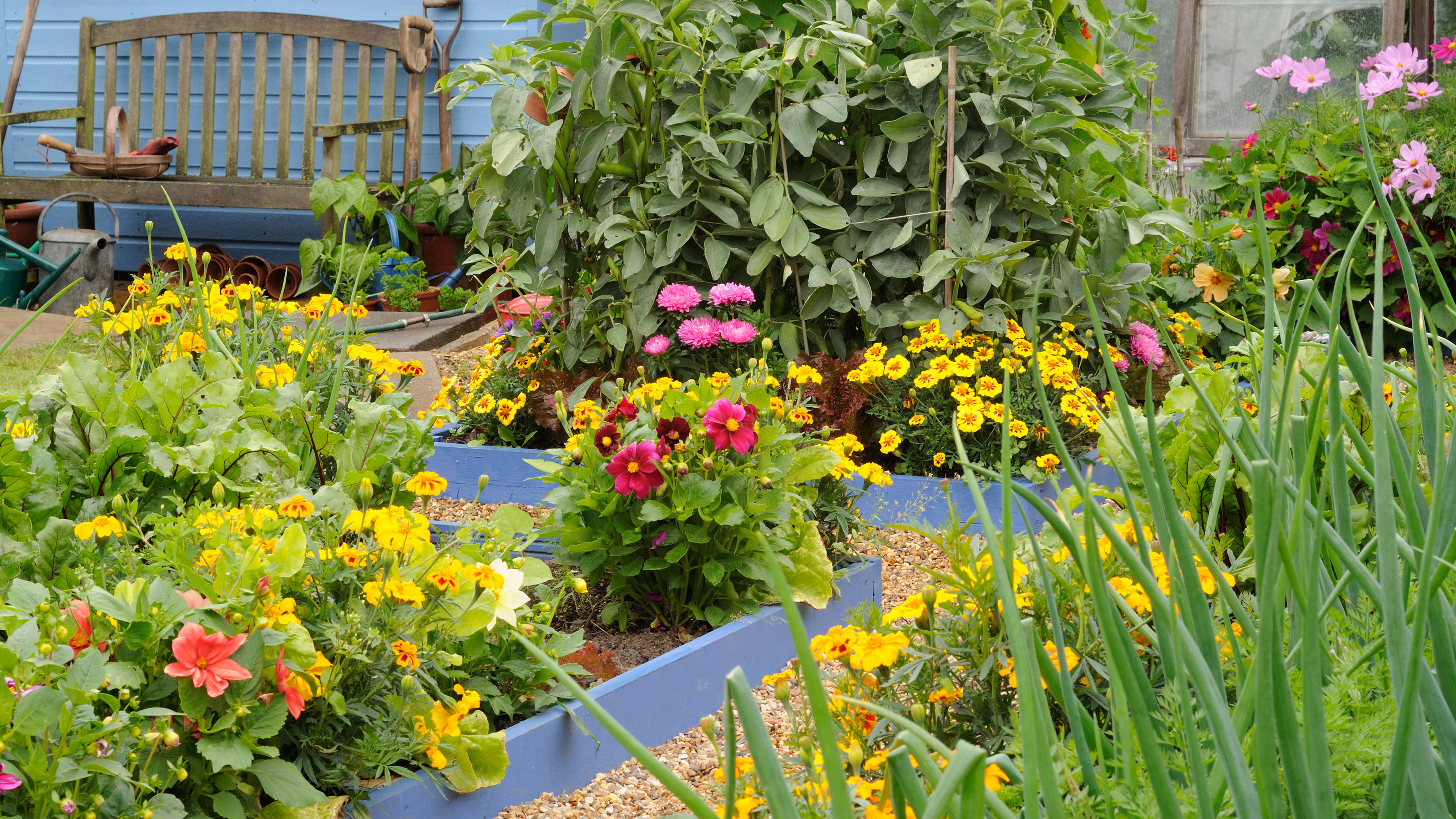

Do you want a garden that looks as good as it tastes? If so, a potager garden could be just what you need. These plots combine attractive edibles and floral medleys in stunning displays that are as pleasing to the eye as to the palate.
We all want kitchen gardens that produce delicious, plentiful harvests with minimal fuss and maximum satisfaction. With a potager garden, you get all that – plus, you get a living spectacle of color and natural beauty. Knowing how to design a potager garden brings creativity in crop-making within easy reach. It also gives you a chance to forge a rewarding relationship between Mother Nature and your kitchen table.
As garden writer Joy Larkcom explains: 'Potagers are like painting pictures in your garden: the colors of the vegetables, flowers and herbs are your palette.'
Here we explore the key ways you can combine edible and ornamental plants in a potager garden. Our tips show you how to design a beautiful and balanced space that is productive, attractive to pollinators and better able to deter pests.
So why not elevate your cottage garden ideas and grow-your-own exploits with a visually stunning and wildlife-friendly potager garden that is picturesque and practical? You'll soon discover that it can be a delightful new way of gardening.
What is a potager garden?
At its heart, ‘potager’ (pronounced ‘poe-ta-zhay’) is the French word for ‘kitchen garden’. Taken literally, the phrase translates as ‘for the soup pot’. It derives from the process of gathering pot herbs for the soup or ‘potage’. And this practice of growing fresh seasonal crops with flowers and herbs is a tradition that stretches way back.
As Val Bourne, Amateur Gardening’s organic wildlife expert and veg enthusiast, points out: 'It is a French tradition that began in Medieval monasteries. The idea was that you would grow vegetables for a potage through the year. Herbs were added for culinary and medicinal reasons, and fruit was included.' Because early examples of potagers were monastery gardens, the notion of healing plays a key factor. The potager garden came to be synonymous with convalescence and rejuvenation.
Much like the produce they contain, potager gardens come in all shapes and sizes. Traditional potagers – such as the Renaissance-themed gardens at Chateau de Villandry – are formal, elegant affairs with symmetrical patterns, repeating themes and knot layouts. Yet alongside this grand style of edible garden has evolved an informal, freestyle interpretation where anything goes. These more intimate potagers are perfect for more relaxed cottage gardens where's there no need to impose endless rules.
As Anne Swithinbank, gardening writer and broadcaster says, 'For me, a potager garden is a relaxed, wildlife-friendly space where the imagination can run riot.'
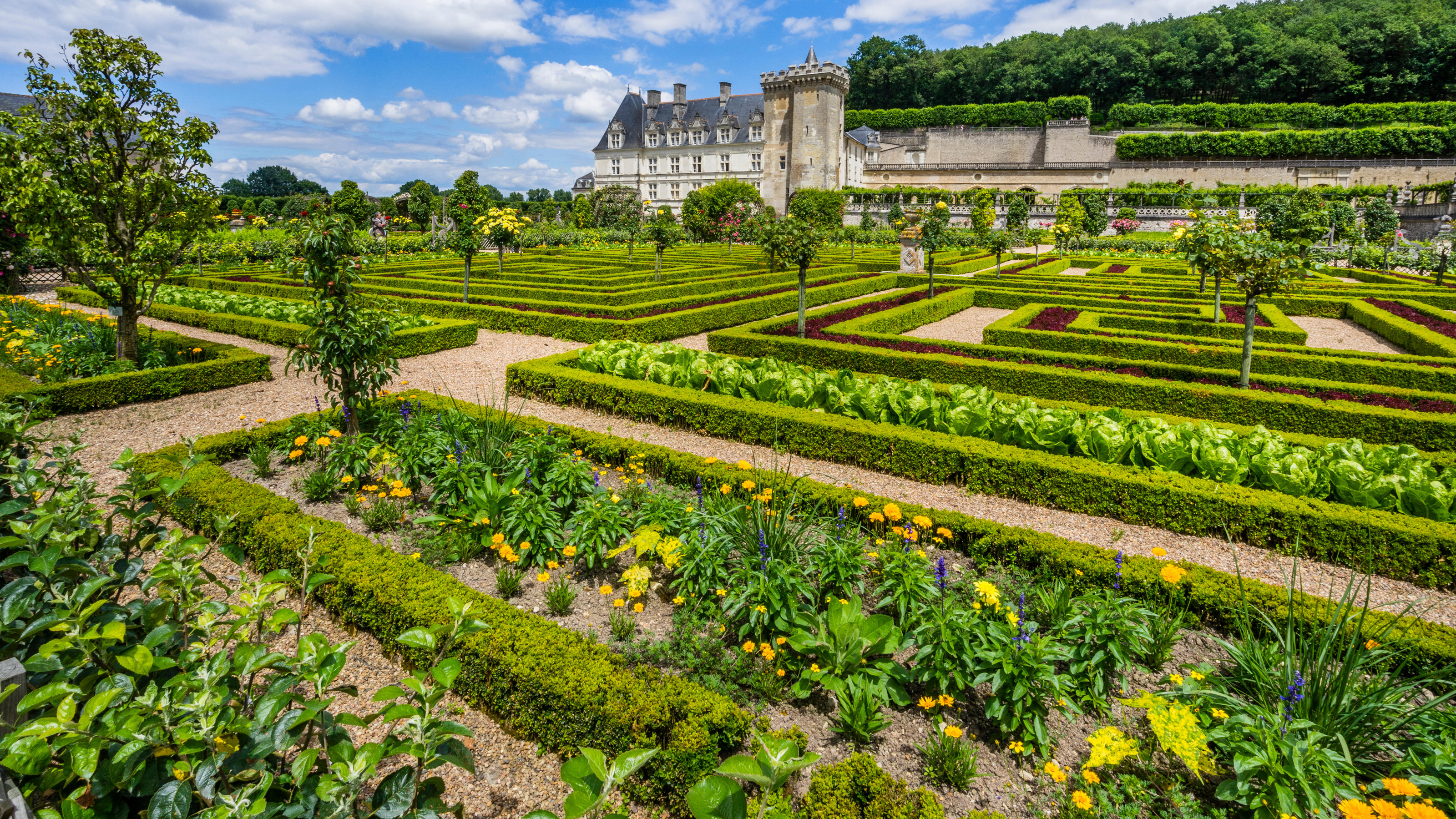
The Renaissance-themed gardens of Chateau de Villandry are a masterclass of the classic potager style
What are the main principles of potager gardens?
Knowing how to design a potager garden involves a sympathetic transformation of your plot. It’s about making a haven of biodiversity where everything works in harmony, plays to the strengths of the seasons and is readily accessible. It’s also about conveying a sensibility of exuberance and romantic abundance. Beyond that, there are few limits!
Award-winning garden writer Graham Rice points to the main principles of making a potager as something that is highly discerning yet also open to interpretation: 'It can mean anything from simply choosing vegetables that are especially ornamental, to creating a formal structure using paths and shrubby dividers, and planting a succession of attractive edibles that provide as much color as flavor.'
You may prefer the more ornate, geometric styles conceived by those French Medieval monasteries of old, with raised garden bed ideas laid out in knots or squares. Or you may favor a more eclectic fusion of flora and decorative edibles, shaped around spirals or free-flowing curves. The key is nurturing that relationship between your natural environment and your kitchen table.
As horticultural experts at Suttons point out: 'Growing vegetables, fruits, flowers and herbs in a more organic way means nature is interwoven into the fabric of the garden. This promotes biodiversity where birds and insects thrive and play their part in the garden’s success, whilst creating a beautiful kitchen garden.'
Our guide on how to attract birds to your garden has tips on bringing birds to your plot.
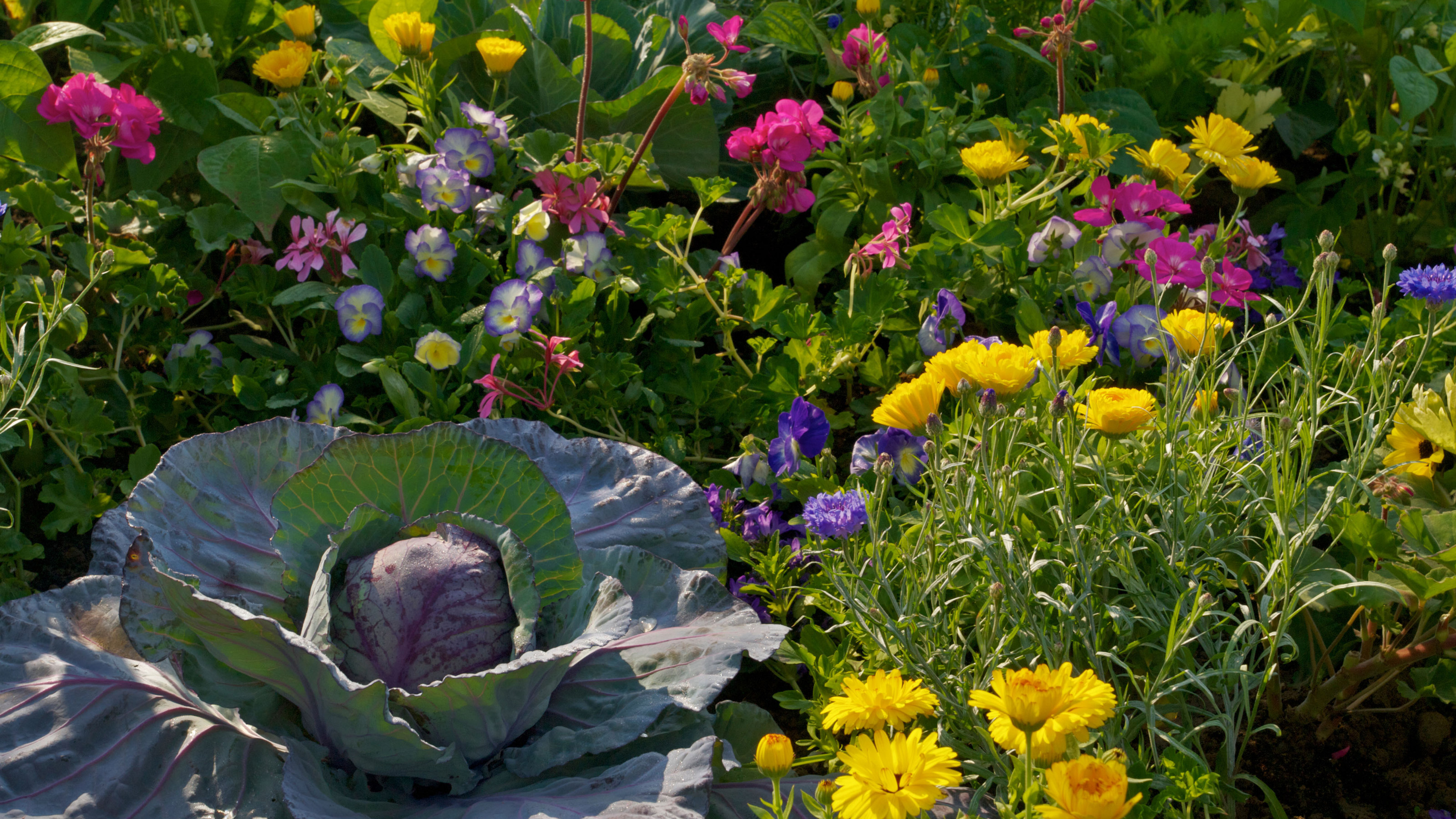
Make your potager garden a place where large leafy veg like 'January King' cabbage coexist happily with mixed flowers such as violas and daisies
Consider the following principles as you decide how to design a potager garden:
- Find decorative twists for favourite plants 'You’re still growing nutritious food for the plate, but you also have one eye on the decorative,' says Val Bourne. Go for veg you love, then add an ornamental twist. Anything you would grow in a normal veg plot should be sustainable, subject to space and growing conditions.
- Balance bounty with navigation Marcus Eyles, horticultural director for Dobbies, says: 'A potager garden should give a feeling of abundance. However, consider walkways, as you need good natural flow between beds for care and maintenance.'
- Create a space that matches your personality As garden writer Joy Larkcom observes: 'A potager should reflect your gardening personality, so go for something you feel happy with. Troubles arise when starkly differing opinions meet in the same plot. Rather than divorce, I’d suggest dividing the plot.'
How to design a potager garden
Figuring out how to design a potager is an enjoyable way to learn about the interplay of cropping plants, ornamentals and nature’s visitors. There is no real right or wrong way to create a potager garden. It’s more about sticking to that simple ethos of cultivating a space that is decorative as well as productive.
Keep in mind that this does not have to be a daunting or time-consuming exercise. In its basic form, it is a series of decorative kitchen garden ideas you can access easily. The rest is up to you!
In terms of basic requirements, you need a spot with plenty of sunshine (at least eight hours a day), and some shade. It also helps for it to be visible from your kitchen window. Apart from that, this style of gardening is highly adaptable. Even if you're searching for small garden ideas or have an irregular shaped garden, you can make a potager garden.
Many first-time potager gardens follow a grid-like design. However, that does not have to be your way. The design you choose is dependent on your tastes and space. Of course, you need to bear in mind that many of your crops will need to be rotated annually. This means redesigning certain elements of your potager on an annual basis.
This style of gardening is open to any budget so will work as part of cheap garden ideas too. Still, if you want to save more money, you can use reclaimed and recycled materials to create your paths, borders and focal points.
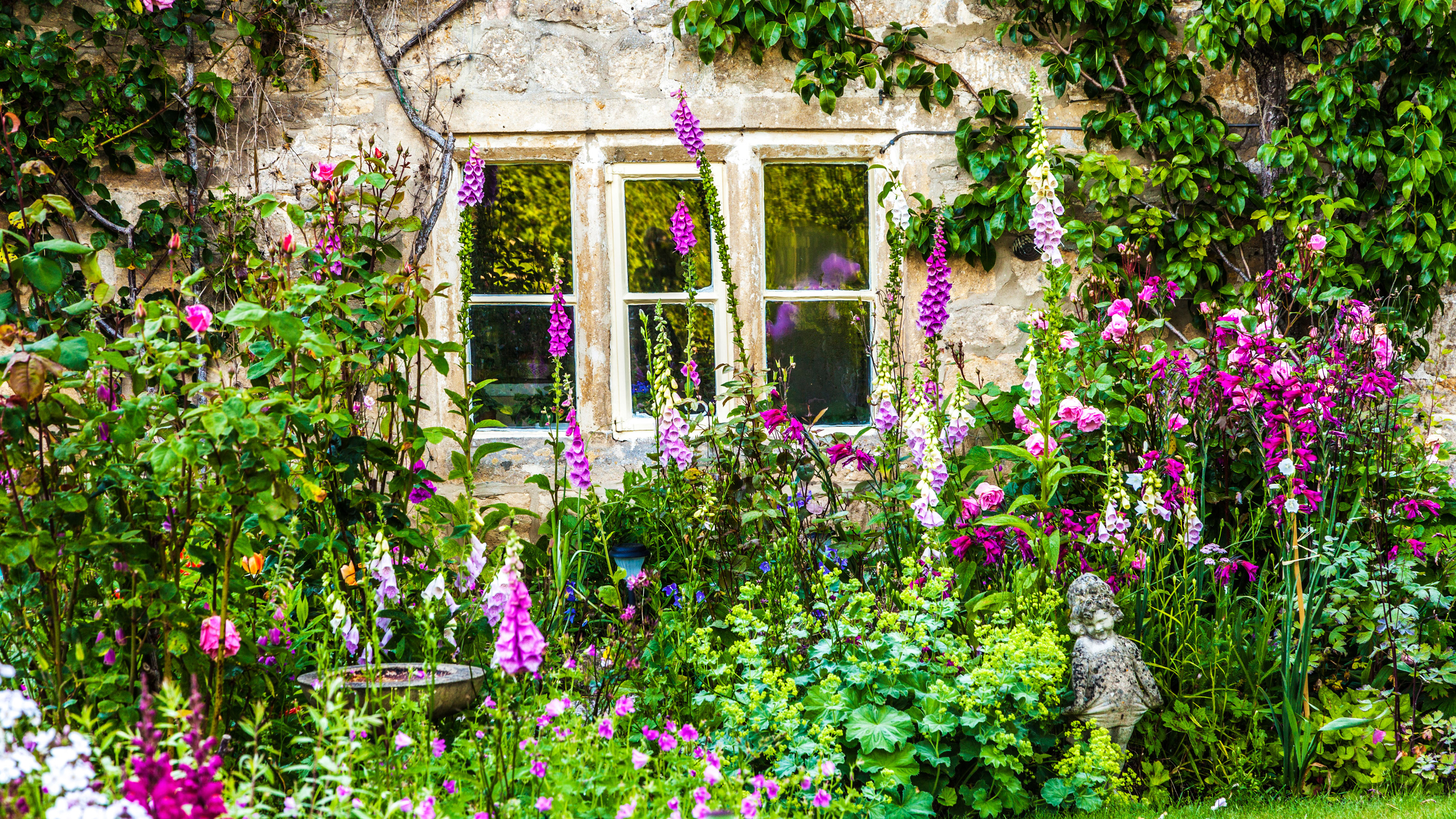
It's a good idea to position your potager so it can be viewed and accessed easily from the kitchen
10 design and layout ideas for potager gardens
Follow our design tips and get inspired to create your own potager garden in spaces big or small.
1. Think creatively with your space
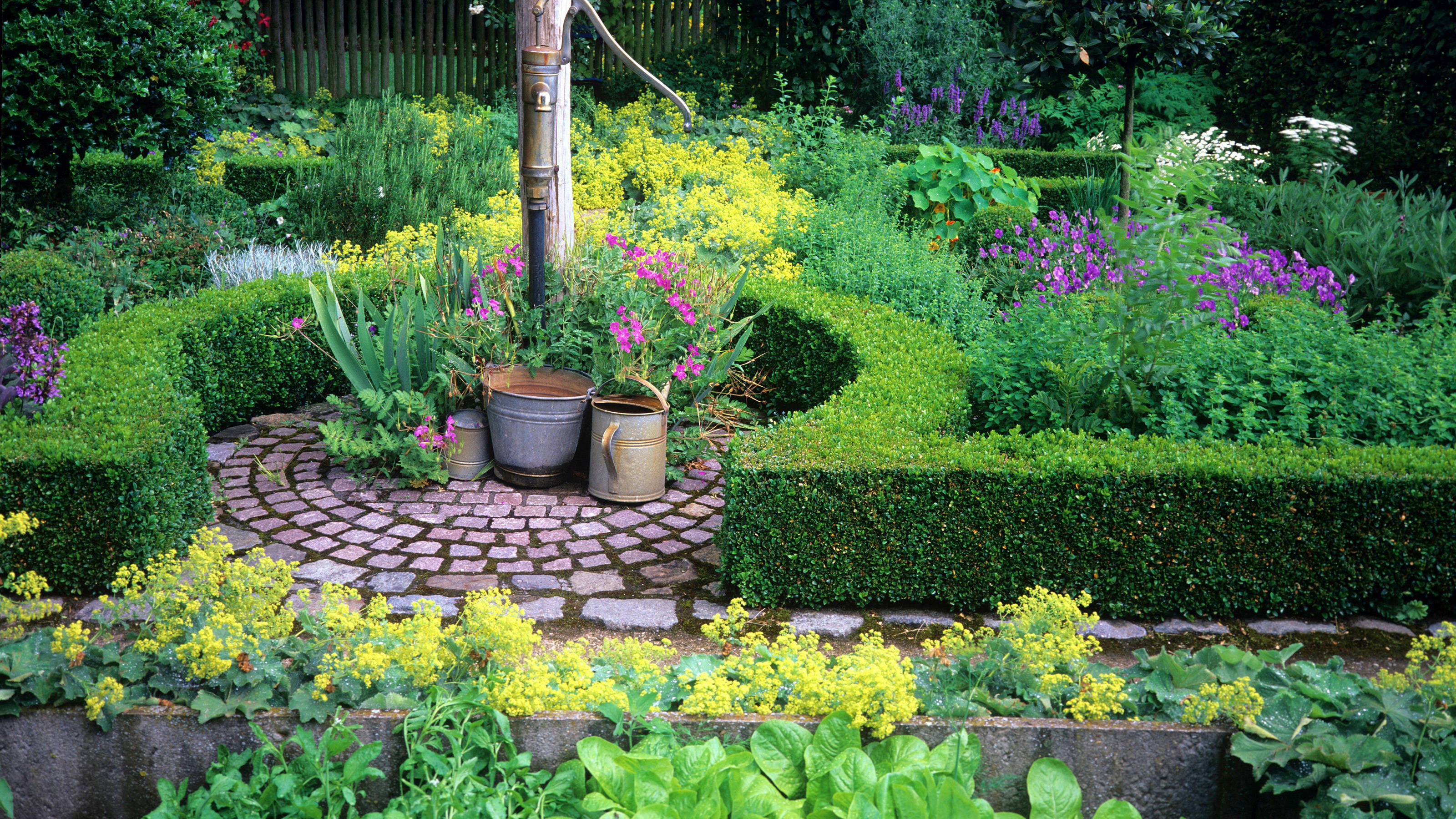
Every potager benefits from a focal point, and even a simple water pump can be turned into something striking with paving and pots
If you want to know how to design a potager garden, the first thing to know is this: abandon any preconceived ideas about what a garden should look like. Why should ‘grow-your-own’ be consigned to a tiny, far-off corner of a garden, or relegated to the edges of the action?
The potager garden style brings your cropping projects front and center where they belong. Adorned with thriving ornamentals and framed with inventive flourishes, your fruit and veg can be appreciated by all.
- Make a focal point 'The right focal point will bring your design together,' says Marcus Eyles. This could be a large specimen container, an archway of clambering beans, a grapevine or clematis, an obelisk, an arbour, a fountain or a fruit tree. You can then use pathways or lines of plants to draw the eye towards and through the focal point.
- Experiment with patterns This can be a repetition of the same plant variety at uniform intervals, or dotted in a particular way. It can also be 'waves' of plants planted in a sequence; try spirals, zigzags, diagonals or concentric circles. 'Simply planting veg in groups rather than in conventional rows can make a great impact,' says Joy Larkcom.
- Go big with plant texture Make the most of any striking textures in the plants you choose. For the best results, choose plant combinations with contrasting shapes in close proximity. Try towering globe artichokes, silvery sage, feathery carrot or fennel, and crinkly kale leaves. To find out how to grow kale, see our guide.
- Get playful with objects Items such as garden spheres, frames, the best garden benches and bird bath ideas add interest and color. They are also a useful way to brighten your potager garden during the winter months. 'Add a cheeky cherub peeking out from under the rhubarb, or a full-blown bust guarding the gate,' says fruit and veg expert Lucy Chamberlain.
- Make your walkways creative These are key, as the space is intended to be walked through. Well-placed garden path ideas add definition to any geometric patterns used in your potager. Get creative with materials used, too. Try old brickwork, bark, stepping stone ideas and pea gravel.
2. Construct well-defined boundaries and edgings
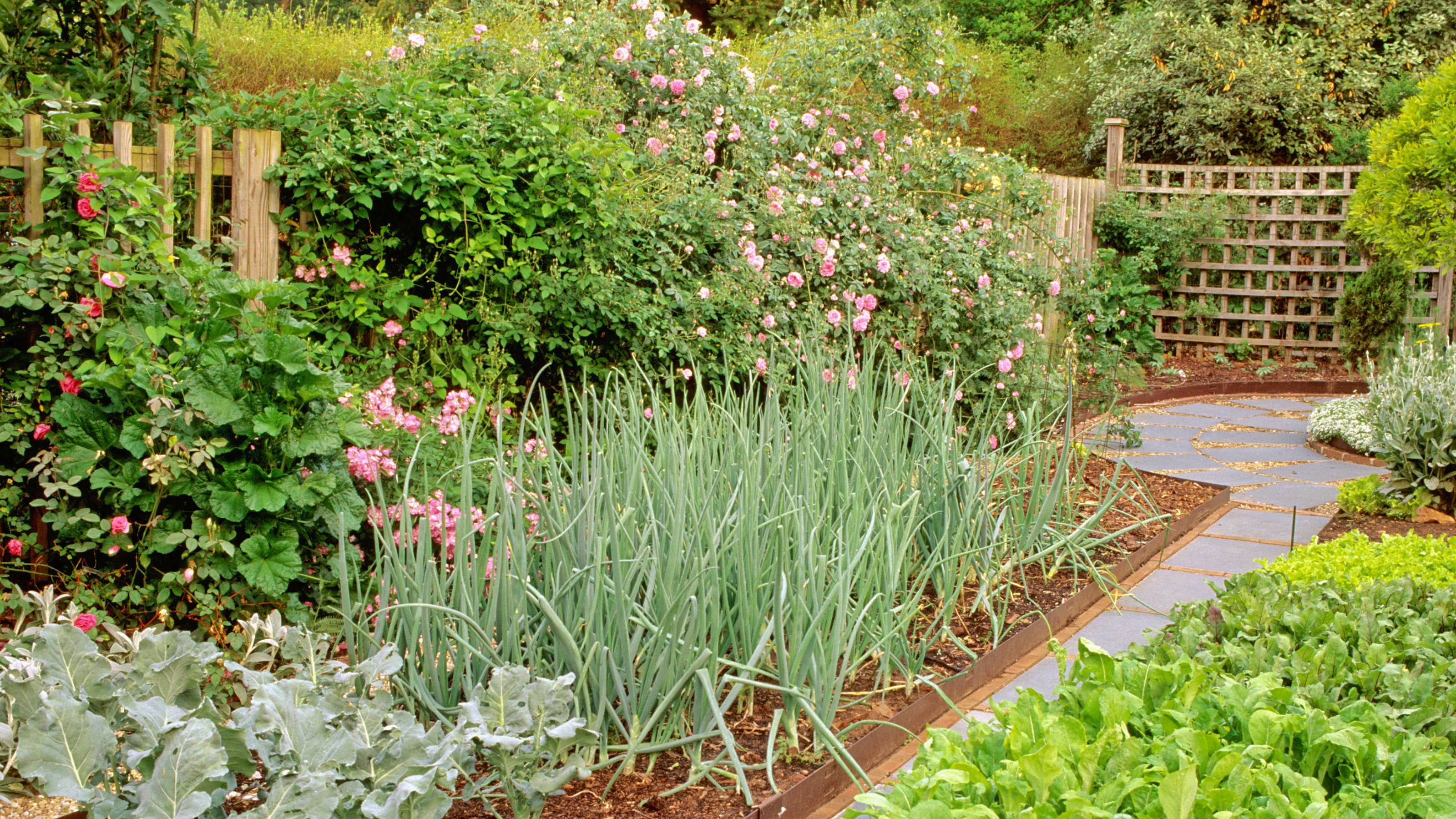
A trellis and a fence with vertical panels and mesh form the boundary for this potager garden of mixed veg and roses
Enclosures were vital in early kitchen and cloister gardens to protect the garden. They also marked out a private, contemplative space of well-being and calm. This is a defining characteristic of the potager, and their function is still crucial. They rein in the wilder excesses of bushier plants and lend definition (and support) to plants.
If your garden doesn’t have a natural boundary like a wall, hedge or fence, Joy Larkcom suggests creating one. 'Training fruit, such as espalier apples, on posts and wires is one way of making an attractive boundary,' she says. Other natural enclosures include currants or raspberry canes. The bonus is they are functional and edible!
It could also be a willow fence, a series of hazel or birchwood screens, or some well-positioned trellis ideas for gardens.
Also consider your garden edging ideas when figuring out how to design a potager garden. Thoughtfully selected edging plants create mini boundaries in the bigger design. They give plantings a neat beginning and end.
Emphasise bed boundaries with shrubby plants, cordon-trained berrying plants or stepover apple trees. Cut-and-come-again lettuce and curly-leaved parsley are also good choices for the best edging plants in a potager garden, as it is easier to harvest them regularly. Don’t forget man-made materials like cobbles or rustic logs too. Joy says, 'Use materials that occur locally, like brick, slate, tile – I’ve even seen lovely beds edged with upturned bottles.'
3. Include lots of living color
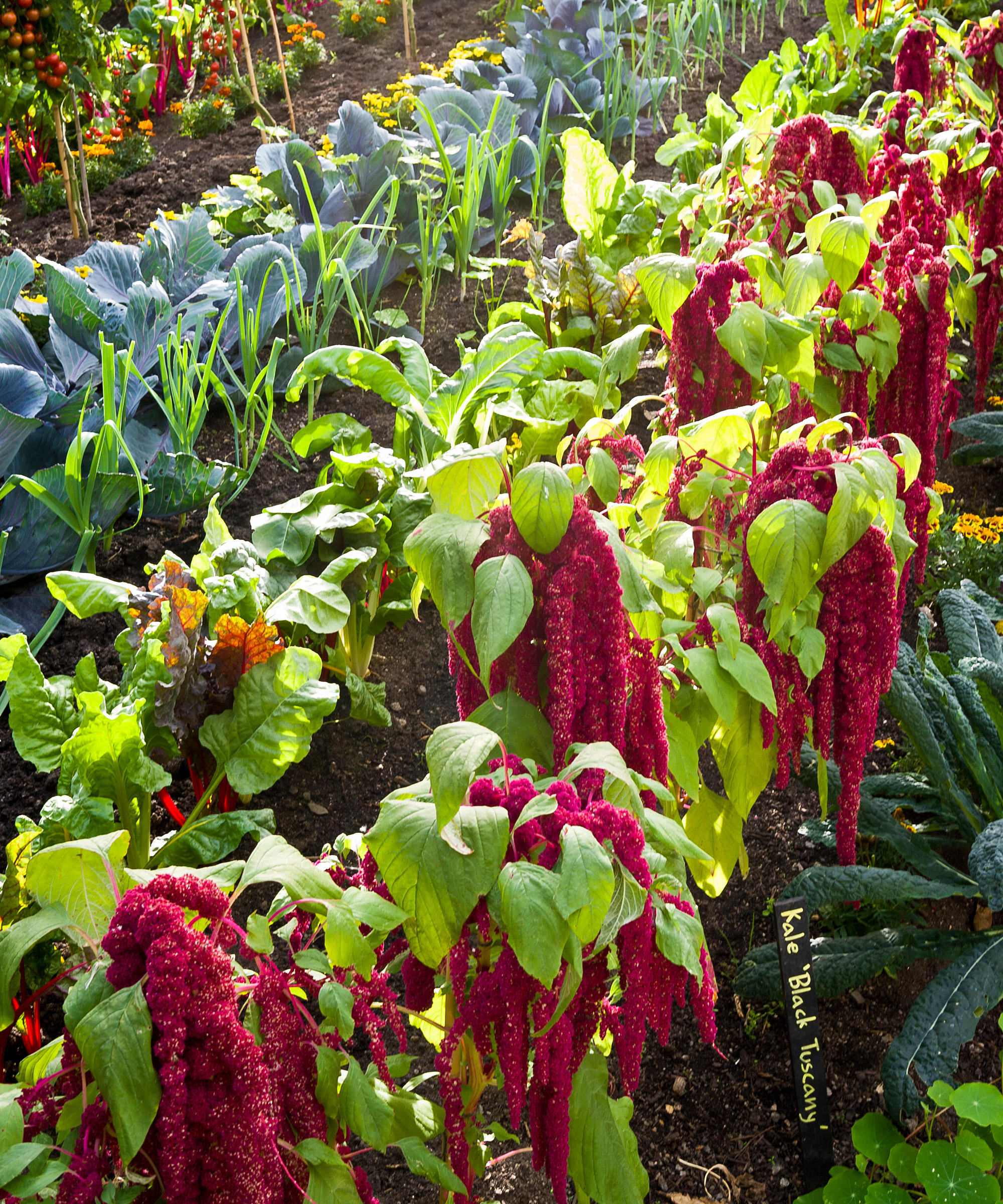
Make the most of naturally occurring color contrasts, such as the blue-green of certain cabbage and kale varieties with the vivid scarlet of amaranthus
Visual dynamics are key when you are figuring out how to design a potager garden. Color is a fun way of being expressive with plantings. This doesn’t mean you have to stray too far from your favourite crops. Thanks to nature and to selective breeding, you can easily switch up the color potential of your plot. You can do this both with a standalone shade and bold color groupings to add interest to your garden color schemes.
As Graham Rice points out, it’s important to choose vividly tinted edibles when the option is available. 'Why plant a green lettuce when you can choose a bronze-leaved one? Why plant a green-leaved sage when you can plant something variegated?'
There is an extra benefit in being creative with color, says Val Bourne. 'You’re confusing the pests by mingling different leaves together!'
Val explains, 'The carrot-root fly, for instance, has no sense of smell: it feels through sensors on its feet. Research has shown that it selects green, but has to get four consecutive hits on a carrot leaf before it will lay eggs.' So by mixing up color in a potager garden, you are boosting pest controls on your plot.
- Pick pops of color Try Swiss chard like ‘Bright Lights’ with red, yellow and orange stems; then pick a few leaves at a time so plants stay pretty for longer. Artful runner beans give weeks of flowers in red, white, peach, two-tone. Heirloom tomatoes offer yellow, pink and purple options. Joy Larkcom also recommends cardoon and bronze fennel.
- Play with contrasts Pair up contrasting tones, says Val Bourne. 'Try green and yellow Courgette ‘Romanesco’ with red ‘Dazzle’ and ‘Little Gem’ lettuce. Or red-leaved kale such as ‘Redbor’ with an all-green one.' Alternate red and green cabbage in a bed. Don’t forget herbs, says Lucy Chamberlain: add hyssop, chives, sage, lemon thyme and santolina. Our guide on how to create a herb garden has more suggestions.
- Try single or similar color groupings Create harmony with blocks of similar color, like orange tomatoes, courgette flowers and russet marigolds. Or violets, purple cabbage and lavender. Joy suggests ornamentals like orange calendula, pink echinacea, gold sunflowers and blue cornflowers. Choose flowers that bloom at different times.
4. Use companion planting in your potager garden
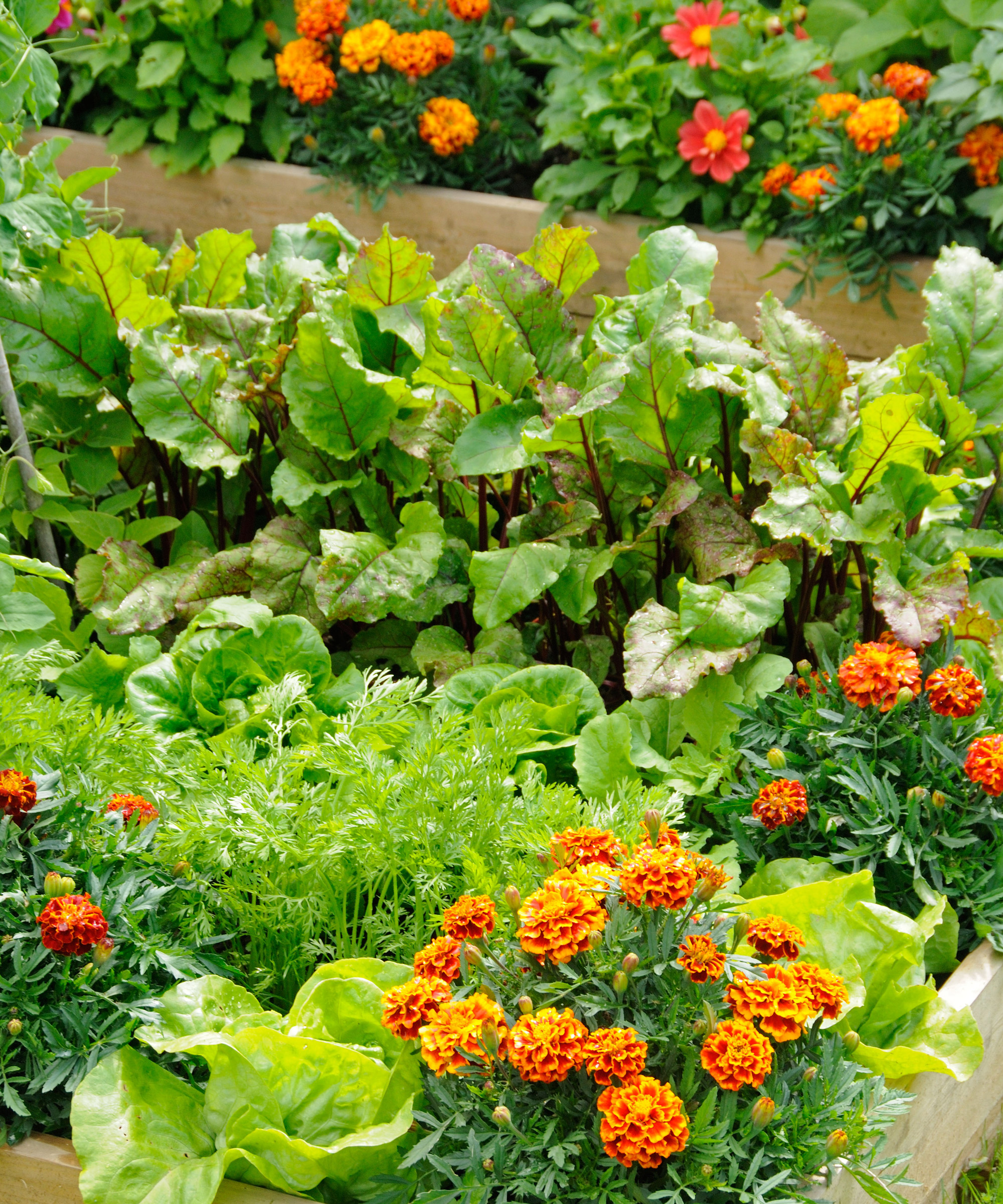
Marigolds planted near lettuce keep pests away, while carrots and lettuce together will help make the most of your space
One of the best tricks in mastering how to design a potager garden is the use of companion planting. It’s a great way to maximize growing space and help ornamental edibles thrive. Companion plants boost growing success, protect from pests, attract pollinators and help increase yields.
The right companion also means you can plant closer together, boost shade and give extra supports for sprawling or the best climbing plants. Plus, they can suppress weeds and enhance soil health.
The experts from Suttons agree that to create a beautiful potager garden in balance with nature, companion planting is a must: 'It is a natural way to protect your crops, allowing Mother Nature to keep the balance in your garden. By gardening smart, you can grow a community of mutually beneficial plants so crops thrive.' What’s more, they thrive in a beautiful way!
Suttons has these suggestions for some popular crop combinations.
- Beetroot: If you're learning how to grow beetroot, it's a good idea to plant with herbs like basil to keep thrips and aphids away from peppers. Planting with peppers can keep weeds at bay (a common practice in the US). Also happy in tandem with beans and brassicas.
- Peppers: French marigolds can help ward off aphids; nasturtiums deter aphids and whitefly. Put dwarf French beans in front of peppers to fix nitrogen into the soil and feed the peppers. Dill attracts beneficial insects. Don’t plant with brassicas or fennel. There's more tips on how to get rid of aphids in our guide.
- Carrots: Try onions and leeks to help deter carrot flies. You can also grow carrots under tomatoes to keep them cool, but leave a gap so as not to stunt carrot roots. Avoid parsnips and celery, which attract carrot fly. There's more tips on how to grow carrots in our guide.
Joy Larkcam also has this tip: 'Mix carrot seed with annuals like cornflower, nemesia, love-in-a-mist and larkspur, and sow together. All summer, the annuals will flower while the carrots will grow steadily and be ready to harvest at the end of year. I do a 50:50 mix of carrot seed with four annuals, mixing two teaspoons in an eggcup before sowing.'
You can also plant basil between tomatoes; lettuce with cauliflower; garlic with strawberries; and calendula with herbs. Not forgetting the traditional American Three Sisters companion planting technique for climbing beans, corn and squash. As Val Bourne points out, the beans climb the corn and feed the soil, while squashes keep weeds down.
5. Build dedicated raised and in-ground beds
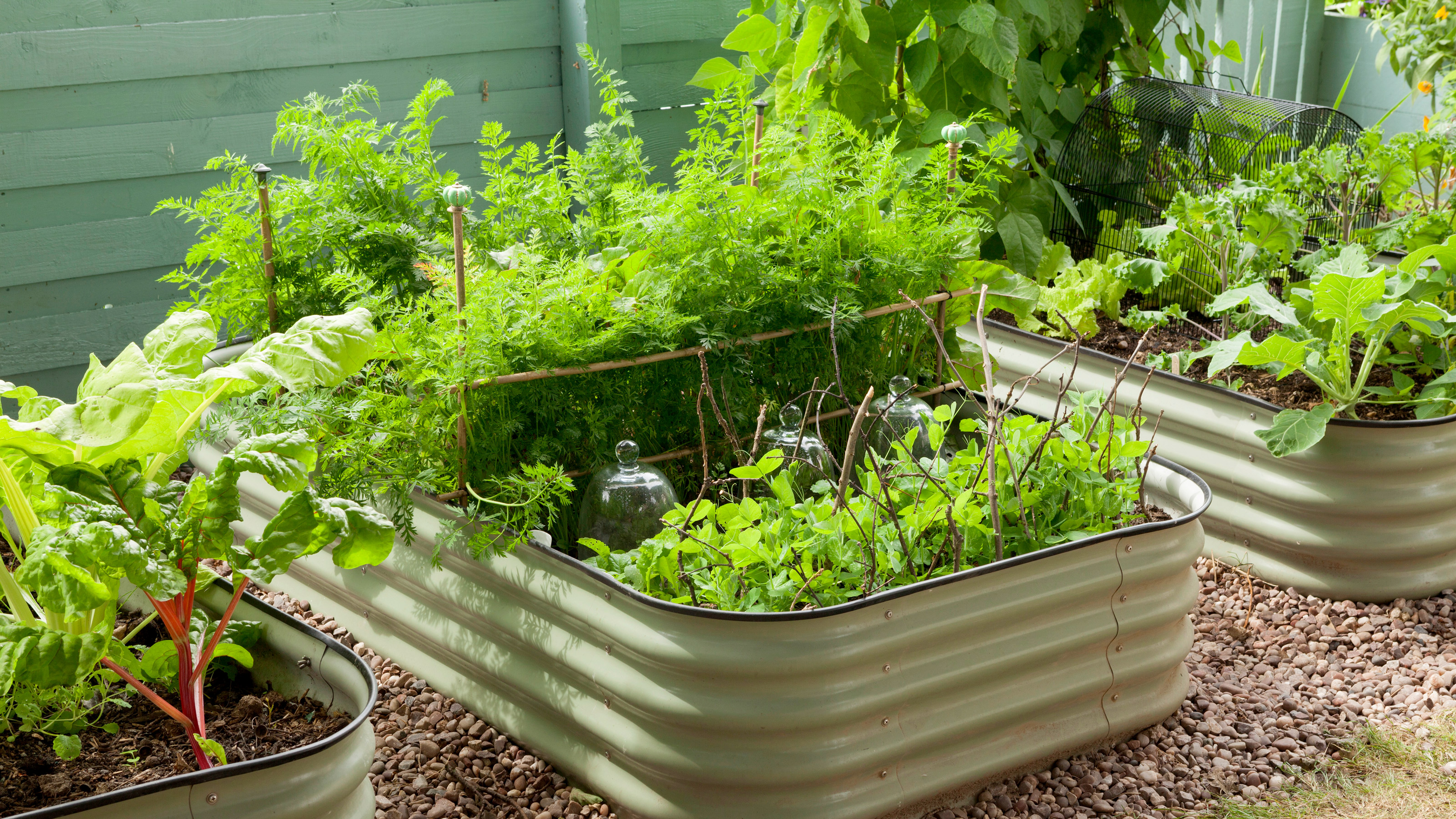
Try galvanized raised beds like the Original Veggie Bed by Suttons
A big challenge when you learn how to design a potager garden is laying out ornamental and edible plants in a practical and attractive way. You can give the layout extra definition, texture, shape and reinforcement with clearly demarcated in-ground beds, raised beds, or a combination of both. These beds also help to create walkways for ease of access to other parts of the plot.
Dobbies’ Marcus Eyles believes raised beds are a key feature of potager gardens, but points out the need to balance visual elements with practical considerations: 'The bed has to cope with plenty of crops and color. You also need to make sure plantings are OK to be sown next to each other.' You can also incorporate large pots or container gardening ideas into your design for bigger veg plants, or to group smaller ornamentals.
Rocks are great for raised beds and in-ground borders. You could also try timber and logs, bricks, galvanized metal, and woven willow or hazel constructions. Fill the beds with well-drained, loamy soil.
Make sure the beds are only four feet (1.2m) wide or less, so you can easily reach across to plant and harvest. Also, make sure your layout can accommodate lots of irrigation points.
Handy at DIY and want to make your own potager garden beds? Our guide on how to build a raised garden bed will take you through the process step by step.
6. Try strategic interplanting and succession planting
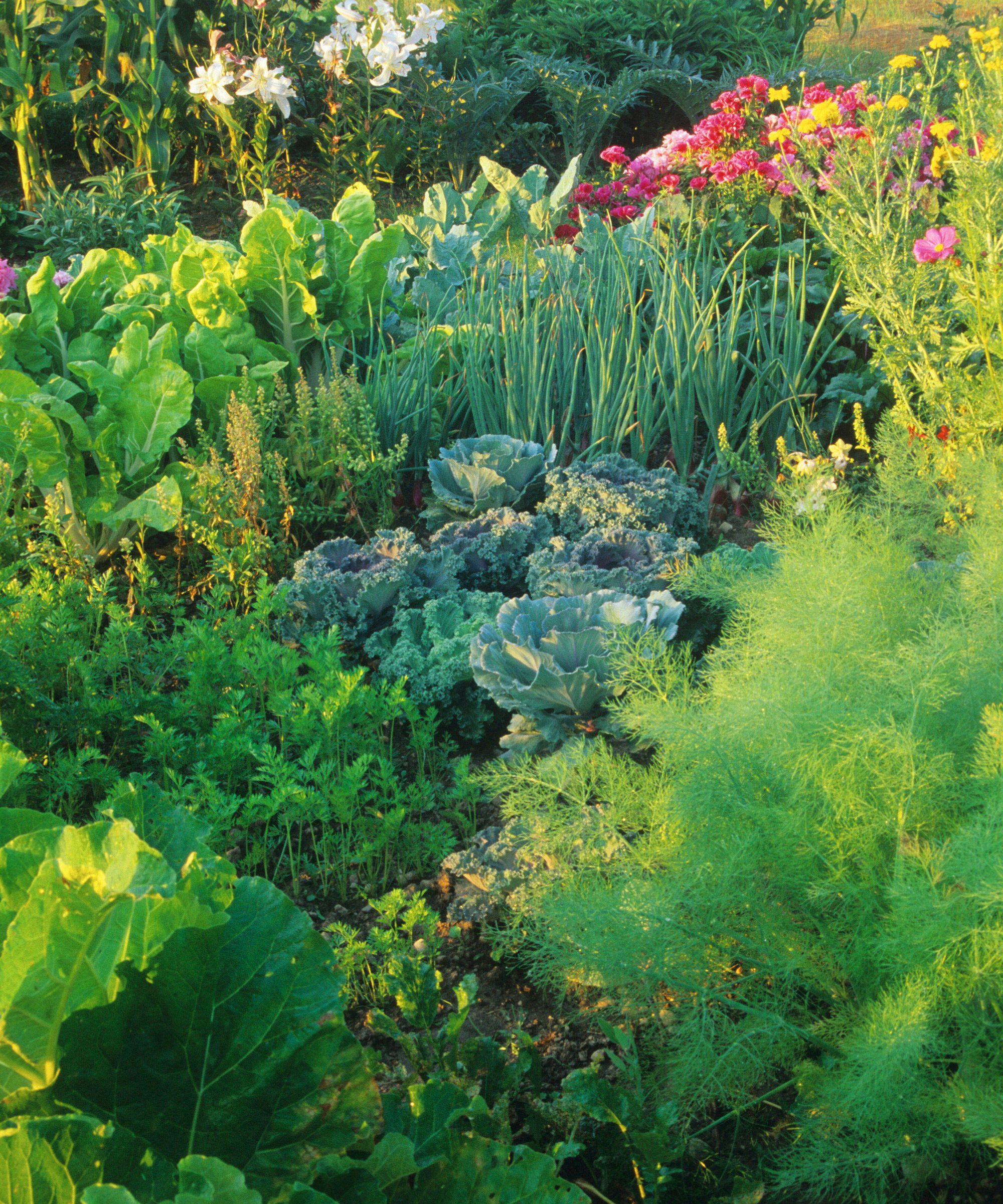
Make more of potager space by interplanting, as with this cabbage, carrot and chard, seen here with godetia and pinks
Knowing how to design a potager garden opens up all kinds of growing opportunities. To make the most of these, you must think (and plant) strategically. Techniques such as interplanting and succession planting can help you squeeze more cropping life out of your garden whilst you enjoy the view. Mastering these growing methods also means you’re less likely to wind up with a glut, or overly mature or inedible crops.
Interplanting means you can grow a fast-growing crop between a slower-growing one, making the most of every spare inch of your potager garden. Pair fast-growing radish with slower parsnips, or lettuce and sweet corn, or beets and broccoli. Anne Swithinbank plants parsley between courgettes, where plants enjoy shade from the midsummer sun. Meanwhile, Joy Larkcom suggests interplanting red and green salad bowl lettuce.
Succession planting involves recycling growing spaces to increase crop yield through the growing season. Plus, it reduces the frustrations of seeing barren spaces in your otherwise lovely-looking potager garden! It can be applied to staggered plantings or sowings of the same veg. Or try different veg in sequence: good crops include beets, carrots, radish and spinach. Replenish the soil with compost in between plantings. For advice on making your own, our guide on how to compost can help.
Fast-growing filler-plants are a great way to fill gaps left from harvesting other crops. Try basil, chervil, cress, cut-and-come-again salads, curly parsley, summer savory, sweet alyssum. You can also grow green manures such as mustard or phacelia. If you want to know how to grow parsley or how to grow basil, our guides can help.
7. Use height in your potager garden
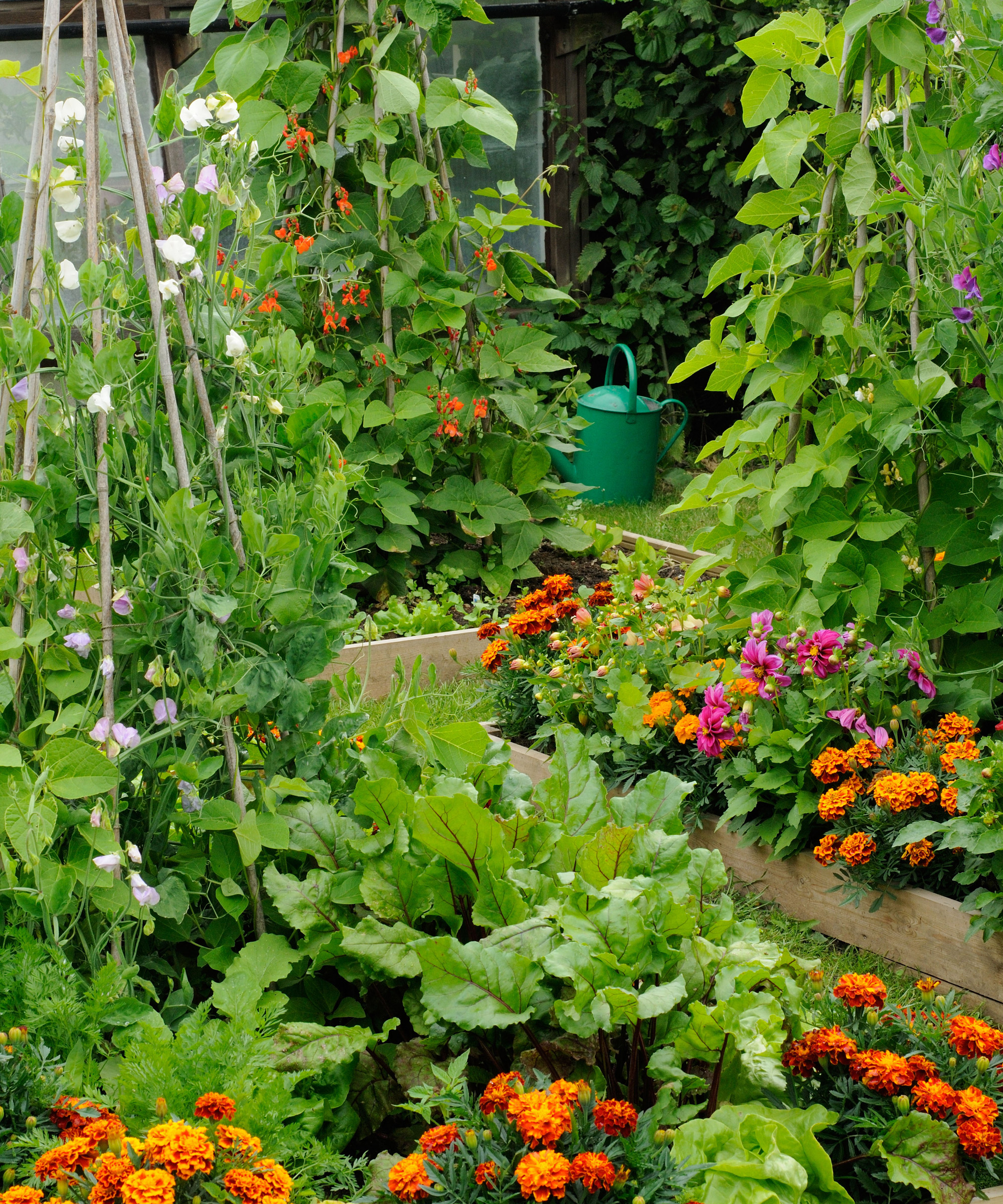
Use hazel and willow to construct pretty and practical wigwams to support climbing runner beans and sweet peas in your potager garden
Figuring out how to design a potager garden means exploring not just space – but height. In design terms, vertical accents create interest and they can even be a good way for how to make a small garden look bigger. In practical terms, they also help you grow more: win-win! So factor in vertical props like a trellis, fence, pergola ideas, a rustic hazel wigwam or similar to support both edible and ornamental plants. To find out how to build a pergola, our guide can help.
As Joy Larkcom points out in her book Creative Vegetable Gardening, just a simple central arch that links beds enables climbing edible and ornamental plants to be grown together. Her advice is simple: create height whenever possible. She also recommends using rustic teepees for runner beans, sweet peas and golden hops. Teepees and arches can similarly be used for cucumbers, marrows and pumpkins. Don’t forget climbing florals, such as the best climbing roses, morning glory and clematis. For more advice, you can find out how to grow clematis in our handy guide.
'Vertical accents transform a potager garden,' says Joy. 'I’ve linked raised beds with arches made from rebar hoops, clad with pig wire. They support honeysuckle, a blackberry, climbing beans, sweet peas and a raspberry.'
What's more, you can also add height through plant selections. Tall perennials and annuals such as gladioli, ornamental grasses, kales and globe artichokes can really ramp up the drama factor. Think also about small fruit trees and large shrubs such as elderberry and blueberry.
And make the most of any spaces around the bases of fruit trees with herbs, or even strawberries. To find out how to grow strawberries, read our guide.
8. Use creative training in your potager garden
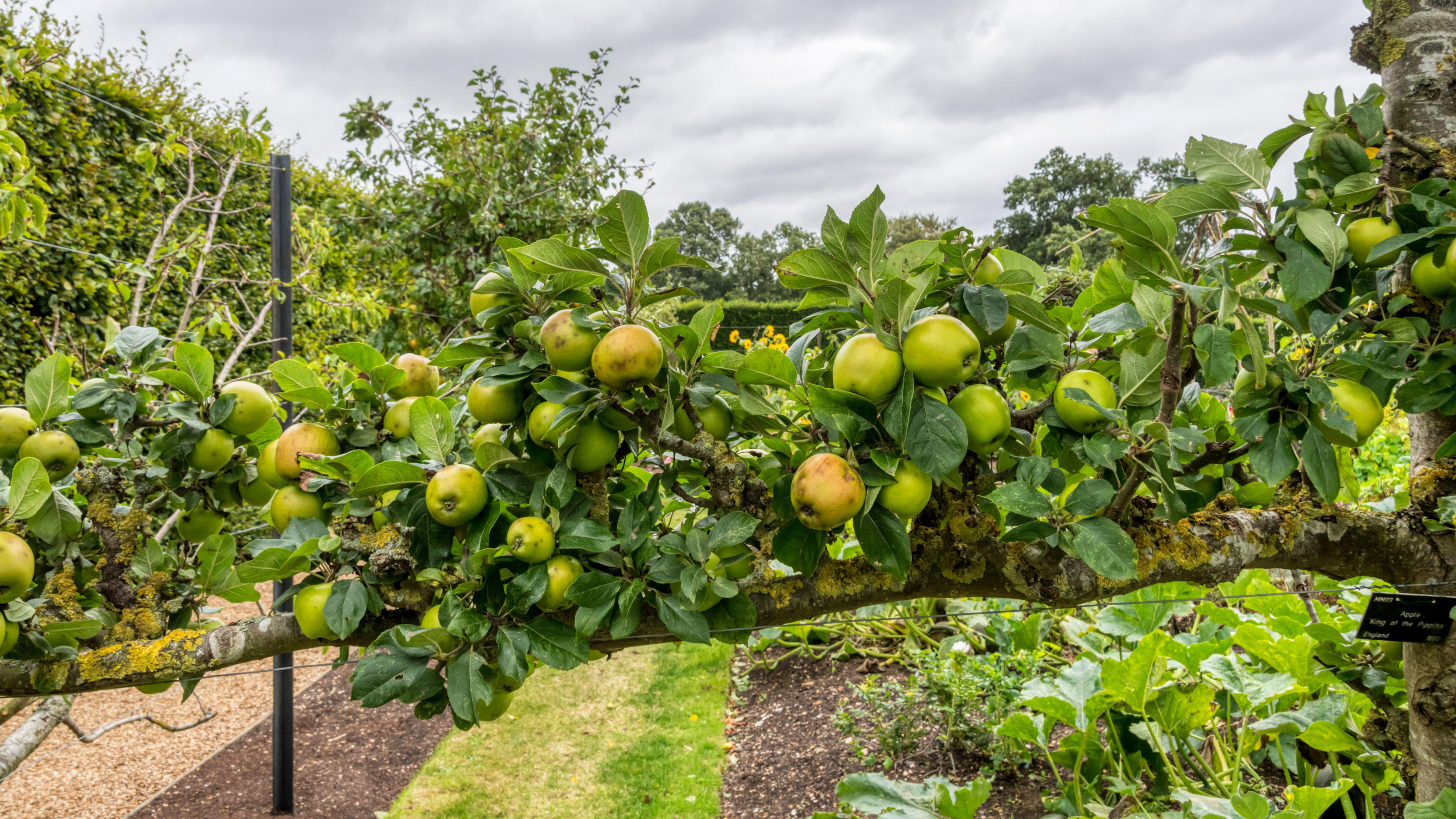
Supporting espalier fruits such as this 'King Of The Pippins' apple on horizontal wire frames helps to create wonderful shapes - and a bigger harvest!
Along with height, color and texture, you can enhance a potager garden with fruit training. Stepover apples, espalier apples and pears, fan-trained cherries and redcurrants – all create movement and striking focal points. As Lucy Chamberlain points out: 'With a little bit of secateur confidence, your edibles can become living pieces of artwork!'
Espalier fruit trees are well suited to potager gardens, and can be adapted to suit any size of plot. Supported against brick garden wall ideas, a fence, panel or wire frame, and fastened in place as the tree grows, you can manipulate the structure into gorgeous shapes. It’s a great way to utilize an otherwise unremarkable wall or fence.
With fruit trees placed on horizontal wires, these trained canopies can give the impression that a potager garden is larger and deeper. By changing the direction of the branches, you also manipulate fruit production – fooling the tree into flowering and fruiting quicker.
Lucy points out that you can even train the stems of hybrid berries and currants into spirals to save wall space. Not only do these methods look good when the trees are fruiting – they also look lovely when they are flowering. If you haven’t already, invest in vine eyes and horizontal wires to help train your fruits into impressive shapes.
Do you need more ideas on how to elevate and support plants in your potager garden? Check out our climbing plant support ideas to see incredible shaping possibilities that can give potager garden plants a lift.
Why not give the following fruit training techniques a try in your potager garden:
- Espaliers Best for apple and pear trees. You can use a brick wall or a wire fence for a see-through effect. A row of currants as a ‘living fence’ is another possibility, says Lucy. Once established, espaliers are a lovely way of creating screens for garden privacy ideas. Consists of one vertical stem off which long horizontal arms or ‘tiers’ are trained. Train tiers in pairs: one to the left and one to the right of the main stem.
- Fans Gooseberries, cherries, gages, figs, peaches, plums, nectarines, apricots and currants can all be trained as fans, says Lucy. The stems are fanned out against a wall, fence, or posts and horizontal wires. Keep the left and right sides equally proportioned. Train against sunny south- or west-facing walls so maximum sunlight reaches crops.
- Cordons A basic cordon consists of one vertical stem off which fruiting spurs arise. Two stems are called a double cordon, three a triple, and so on. Main stems that are tied in at an angle (instead of upright) are called oblique cordons, says Lucy.
9. Make your potager garden wildlife-friendly
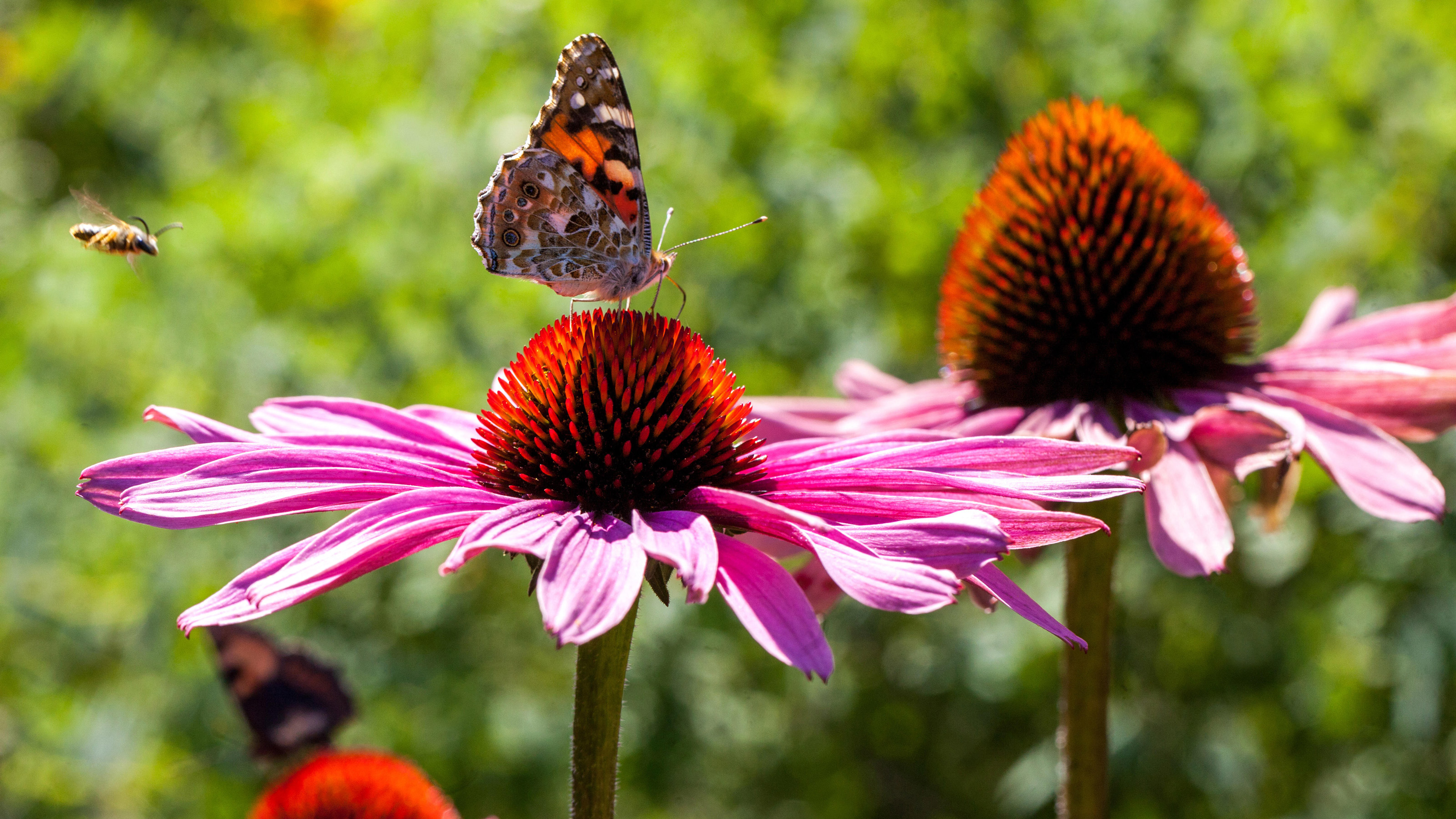
Adding coneflowers (echinacea) to a potager garden will attract all kinds of butterflies, including painted ladies
Once you know how to design a potager garden, you can create a lovely, productive outdoor space that's a great addition to your wildlife garden ideas. In addition, certain floral selections can attract beneficial pollinators. Including lots of bee friendly plants is also good news for any cropping plants requiring these insects to produce fruit. Something as simple as a rambling rose can make a difference.
Anne Swithinbank’s recommendation is to plant forget-me-nots: 'As well as being great for posy vases, easy to pull out where you want to clear a bed, and good compost heap fodder – they attract pollinating insects for a good set of beans or strawberries.'
Val Bourne suggests easily grown annuals with simply shaped flowers to attract bees and hoverflies. Yellow and orange flowers are especially attractive. Hoverflies are useful, says Val, as most have larvae that clear up pests like blackfly.
She continues: 'Many herbs produce concentrated nectar, so you’ll attract butterflies as well as bees. Also, Phacelia tanacetifolia produces arching mauve-blue flowers in early summer, which attract bees. The remnant can be dug in as a green manure.'
Place some calendula, echinacea, sunflowers, cornflowers, open cultivars of dahlias, shasta daisies, tagetes, borage, goldenrod, snapdragons, nepeta and nasturtiums near any crops. Ditto woody shrubby plants like butterfly bush and lavender. Quite simply, you’ll have a front row seat for some of nature’s loveliest visitors.
Want to welcome even more pretty pollinators to your garden? Our guide on how to grow a butterfly garden has plenty of plant inspirations.
10. Choose inventive themes for your potager garden
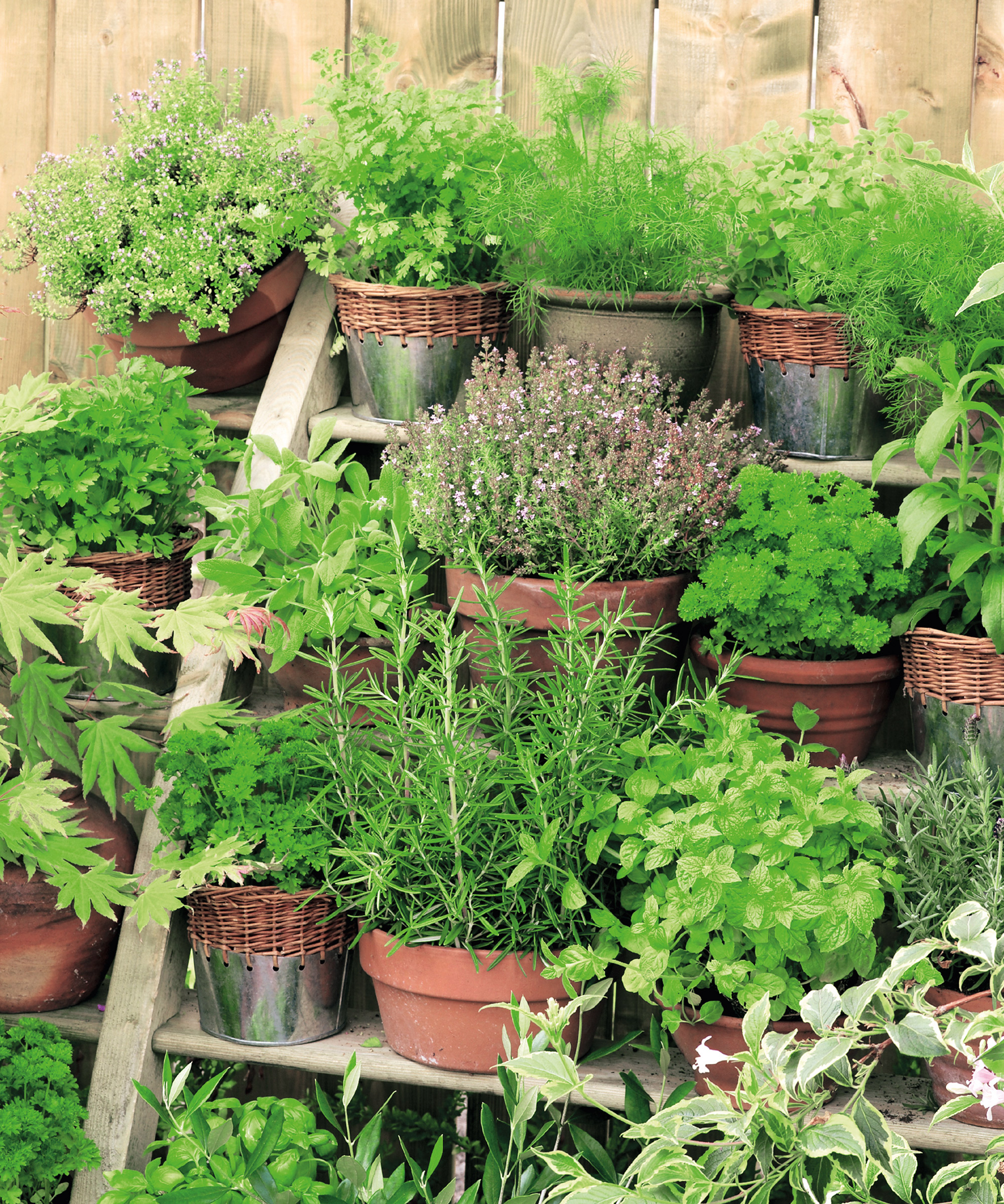
Terracotta, rattan and metallic themes all create pretty accents in a potager garden, as with these thematic herb containers from Suttons
Our tips for how to design a potager garden aim to balance the productive and decorative aspects of this kind of garden. We’ve explained how important color, texture, height and edging can be. While these ideas are fun to explore, it might be hard knowing where to start.
For this reason, it’s worth having a theme in mind – it can kickstart a lot of the detail, and serves as an anchor and unifying design element. Here are three key design themes to get you started:
- Galvanized Watering cans and containers made with this distinctive material add a vintage feel. Incorporate this brushed metallic texture into raised beds, water features and frames for climbing plants.
- Bricks Laid flat as a path or up-ended as bed edging, crumbly red bricks, dappled with moss or lichen, work well with a host of plant colors. Develop this in the pathways, and as a backdrop for trained fruit.
- Terracotta Ditch the plastic and pot up herbs, chillies and salads in this gorgeous earthenware. Terracotta makes lovely accents or standalone pieces like a traditional rhubarb-forcer.
Upcycled and personally crafted products can also be used to personalise your potager garden. Shabby chic is a popular theme for a potager, utilizing crumbling ceramics and crackle glaze pieces that would complement other rustic garden ideas used elsewhere in your plot. This aesthetic helps convey the sense that your potager garden is well established, well lived in – and well loved! Or you could take your theme in a more woven direction, with rattan pieces to complement willow or hazel frames.
Want more inspiring ideas on how you can work a visual theme into your potager garden? Our garden planter ideas can help.
How do I plan a potager garden?
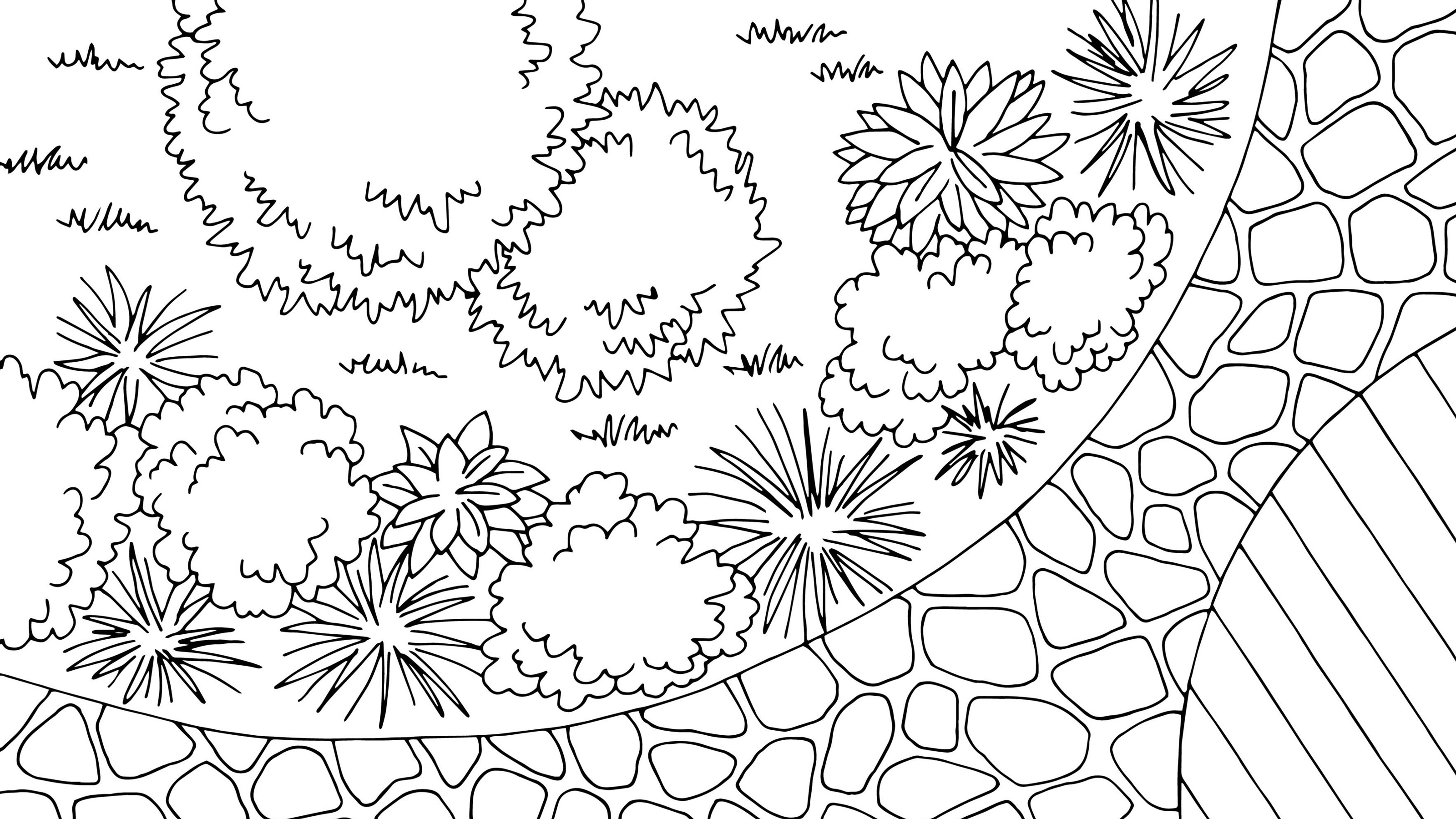
Putting pen to paper is a good way of formulating the basics of your potager layout and seeing how ideas can work in practice
With lots to consider in deciding how to design a potager garden, it’s important to take stock of what is needed, and what is possible. Long-standing potager advocate Joy Larkcom is a big believer in taking the time to consider how to plan your garden design, even if you need to change your plan further down the line.
'If you are creating a potager garden from scratch, a key element is deciding on the shape, size and arrangement of the beds. Remember you can throw convention to the winds and have beds of any shape: round, crescent shaped, diamond. Think of it this way: a cabbage really doesn’t care what shape of bed it is growing in!'
Arranging beds in patterns changes the feel of the garden: diagonals, zigzags and blocks produce unique dynamics. Just don’t forget you need to be able to reach the centre of each bed from the path, Joy cautions. As a general rule, a potager garden needs at least four beds and a grid-style can work well with pathways in between.
Stand in your garden at different times of day to get a sense of light and space. Look out for large trees casting shadows, awkwardly placed structures, and so on. Lay out ‘placeholder’ objects like planks of wood as mock-ups for key features. It is also wise to sketch a scale drawing before setting things out for real.
Bear the following in mind with your potager garden:
- Accessibility and vantage points are key for potager gardens, so think about where you will get the best view, and for most often.
- Your layout (particularly the width of pathways) needs to be informed by the shape and size of any equipment (ie wheelbarrows).
- As the seasons shift and your ornamental and edible plants grow, the outlines of beds will naturally evolve and need further attention. Consider the best layout to suit your available gardening time.
- Are any prospective plants likely to ‘take over’ or dwarf surrounding crops? Aggressive herbs like mint are best kept in pots - there are tips on how to grow mint in our guide. You could also pot edibles like blueberry, citrus, olives and nasturtiums to save space.
If you're short on space too, you might want to consider growing vegetables in pots. - Also, think about how your plot will look in winter, and plan a potager garden to work across the seasons. Joy Larkcom has designed separate winter and spring potagers.
- For continuous interest in winter, factor in evergreens or trees that provide colored branches (like dogwoods), flowers like winter honeysuckle and winter pansy, and crops like winter brassicas. To find out how to grow winter brassicas, see our guide.
Can I have a potager garden in a small space?
The key thing with knowing how to design a potager is that it can be attempted in any garden. Yes, elements such as shaped walkways may require more room to make much impact. But even the smallest garden can be transformed. As Marcus points out, a potager garden can be a great way to make the most of a modest space.
Anne Swithinbank says, 'If you only have a small garden, turn the whole thing into a potager. Start work in the autumn by removing non-productive plants. Keep thickety plants at the edge, because birds will need these for nesting. Boundary plantings of hazel and beech are great for cutting natural plant supports during winter when dormant.”
If you would like more inspiration on how to get more from a compact plot, our small vegetable garden ideas can help.
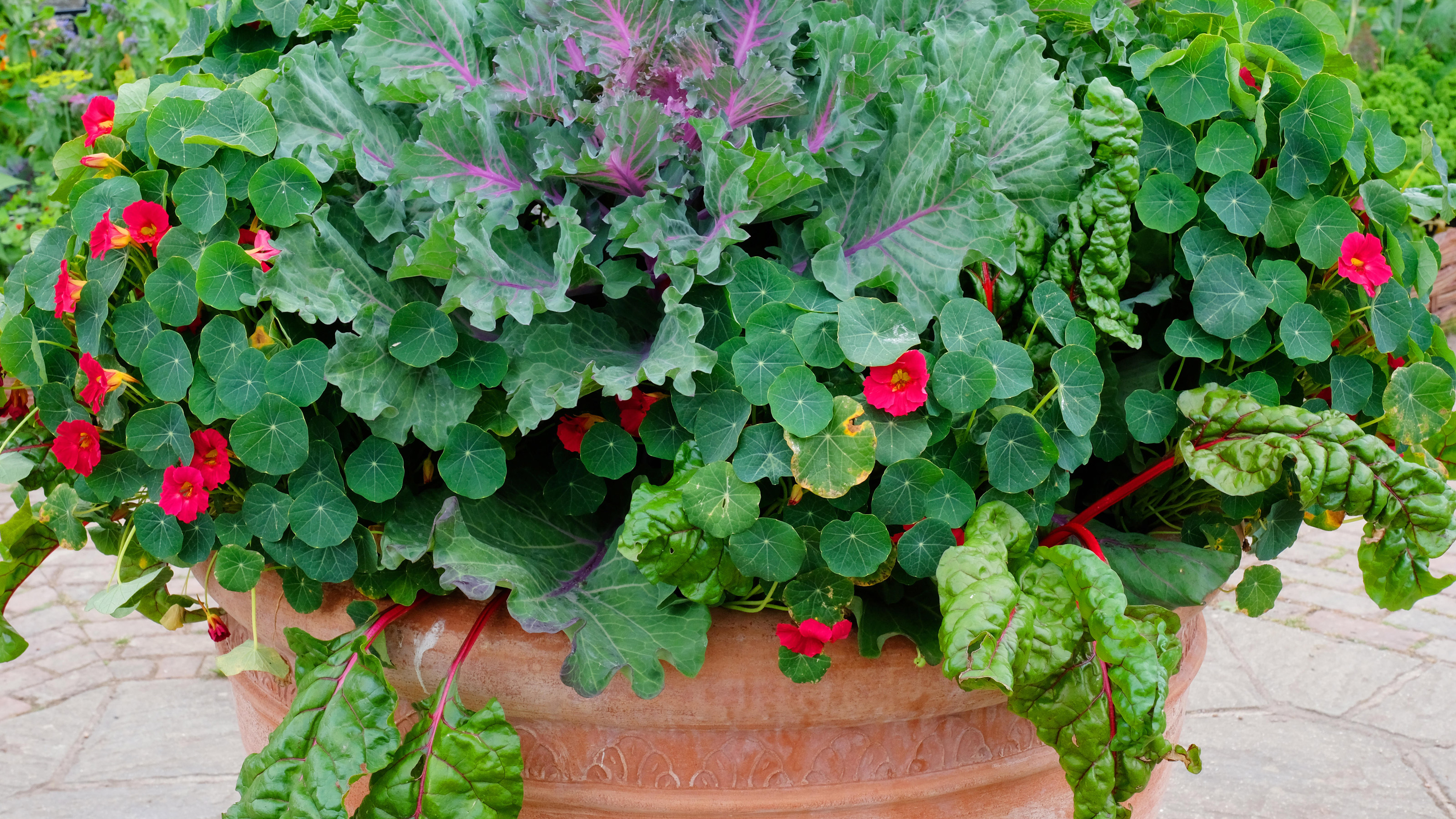
Make the most of available ground space in smaller gardens by utilizing containers for mixed plants such as nasturtiums, cabbage and Swiss chard
Should I have box hedges in my potager garden?
You’ll no doubt have seen classic, formal potagers that incorporate tidily shaped box hedges. Traditionally, these would add definition to boundaries and garden borders, and looked impressive in knot layouts or clipped into box balls. However, as several of our experts have pointed out, box hedges are pest- and disease-prone.
'Box is a snail trap,' says Val Bourne. 'It’s surface-rooted so it dries out the soil, and it’s now prone to blight and box caterpillars.' Val prefers to use lettuces and shallots as a striking and colorful choice for edging. If your heart is set on a tightly clipped look, Val suggests the variegated form of box called ‘Elegantissima’, which is less prone to blight. Lucy Chamberlain also recommends the evergreen honeysuckle (Lonicera nitida).
Do you want to know more about growing hedges for your garden boundaries? Our guide to the best fast-growing hedges for your garden can help.
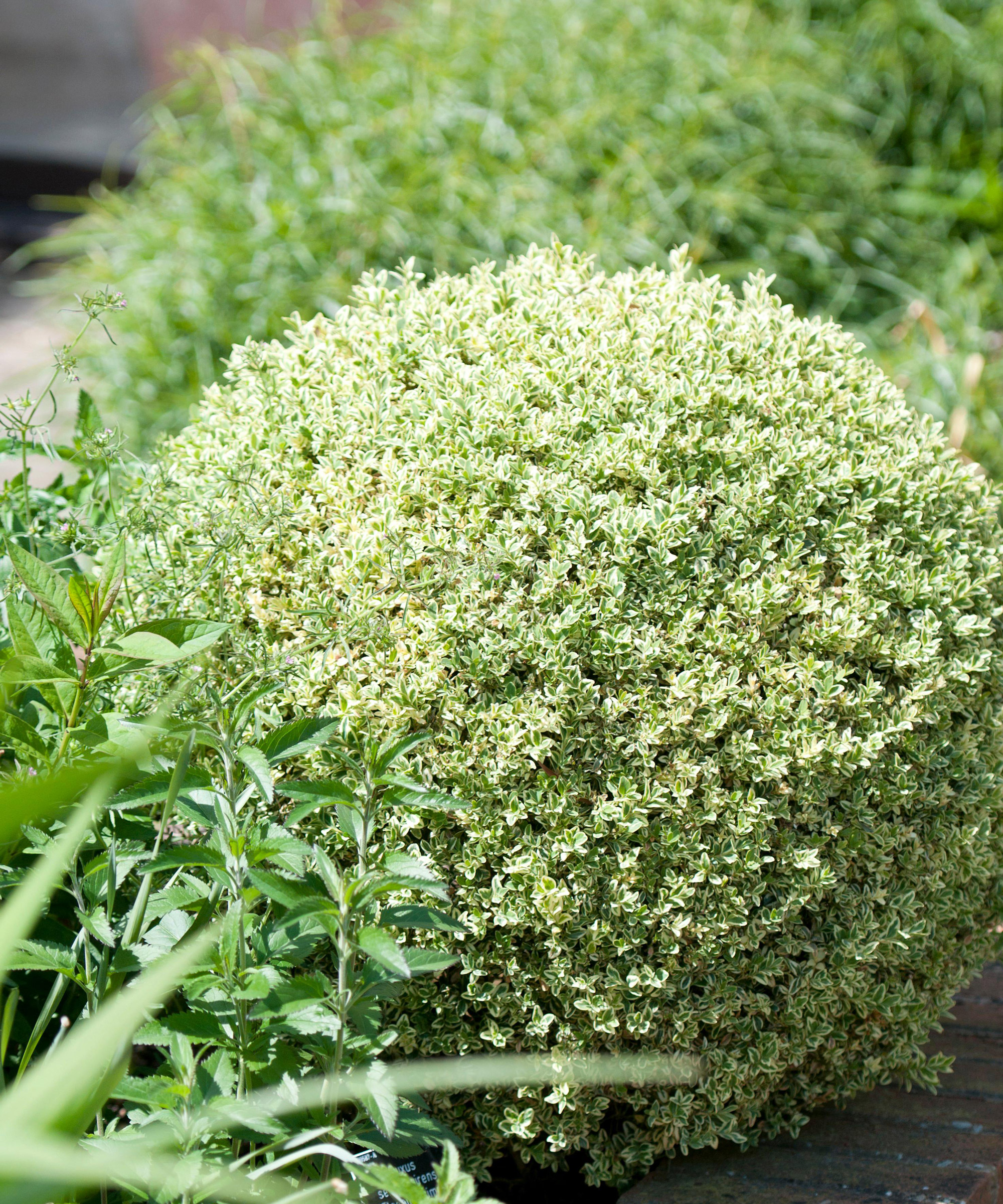
Some varieties of box are susceptible to disease, but if you want tightly clipped hedges, you can always try 'Elegantissima'
How can I save time with my potager garden design?
So now you know how to design a potager garden. But if our tips have given you a lot to think about, we have some good news. You can save time if you add some self-sowers. These easy growers add endless charms to a potager garden. Because they self-sow, you can appreciate new blooms year after year with minimal effort.
Choose a mix of self-sowers that flower at different times to stretch out the season of color. Alternatively, mix and match for a patchwork of pretty blooms.
Try some fuzzy globe thistle, love-in-a-mist, poppies, sweet peas, bellflowers, primrose and primulas, cosmos and honesty. Other self-sowers include mallow, columbines, nicotiana, corncockles, hollyhocks, phacelia, gaillardia and valerian. Not forgetting some of the best edible flowers and plants like chamomile, dill, fennel and many varieties of viola.
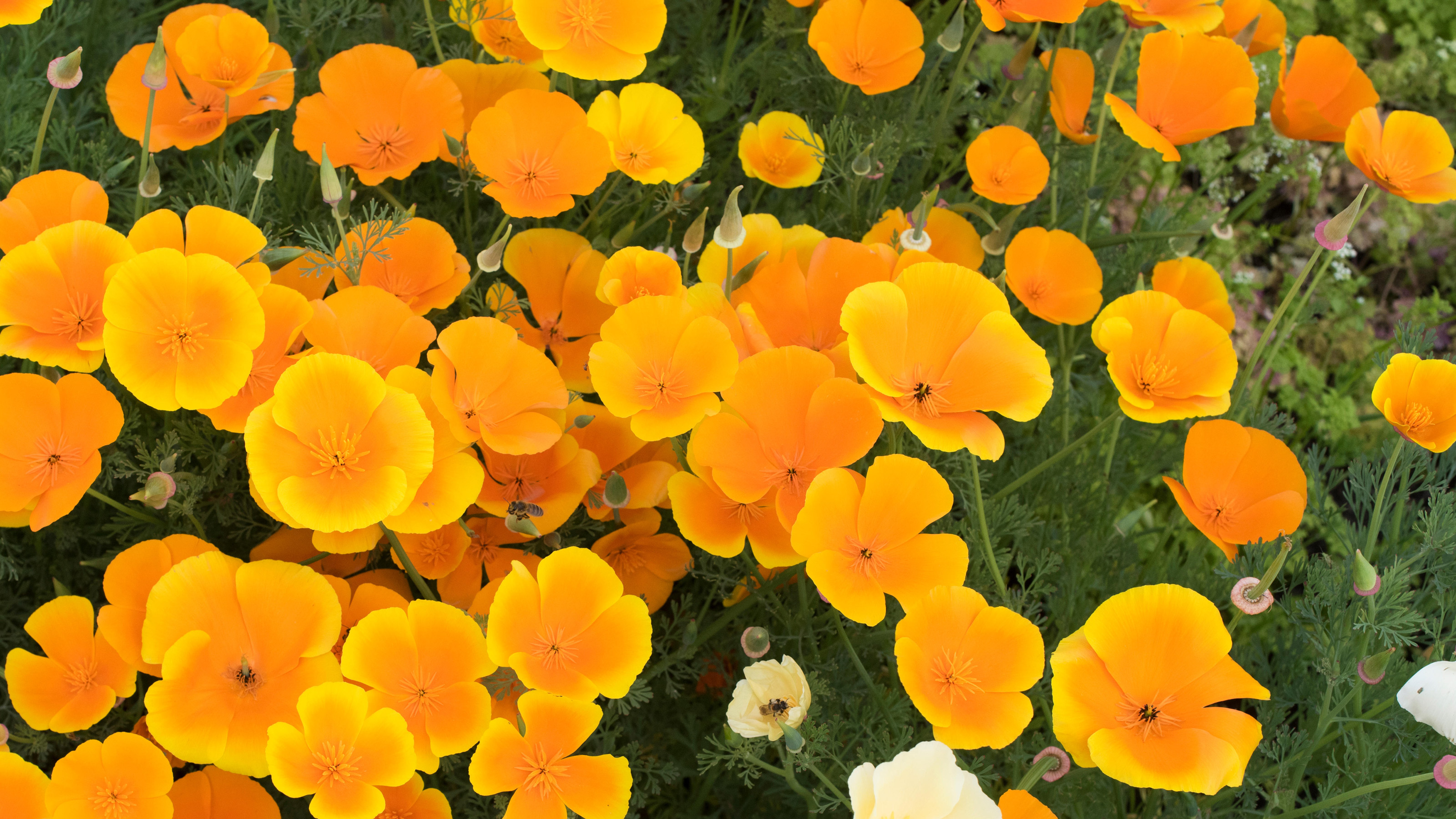
Enjoy years of easy color in your potager garden with self-sowing beauties like these Californian poppies
Inspirational potager gardens to visit
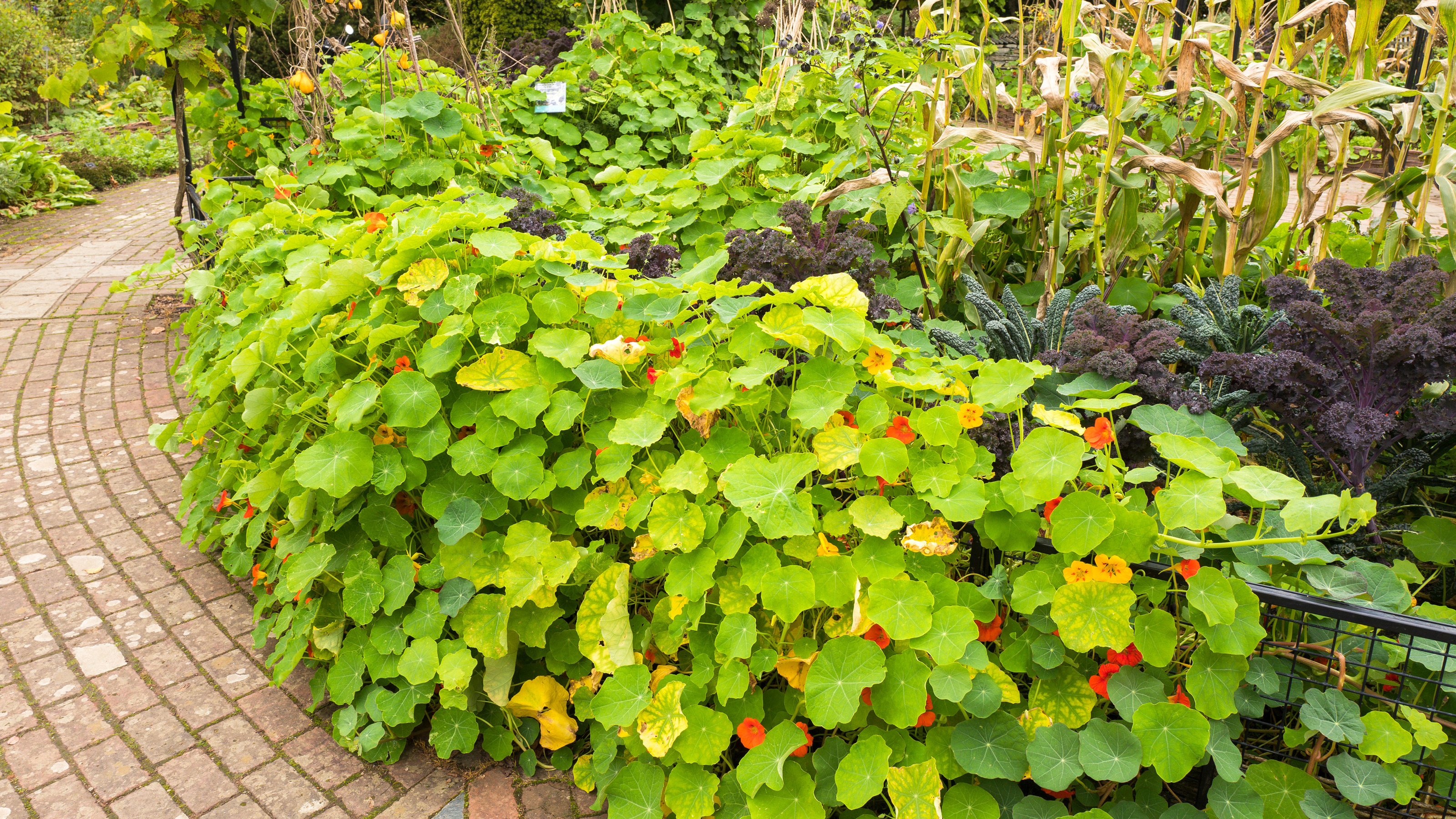
If you need more inspiration, check out a public potager garden such as the one at RHS Rosemoor
Plenty of public examples of potager gardens use many of the strategies covered in this guide. Whether you prefer the formal style or the cottage garden approach, you’re sure to find something to inspire your design. If you can’t get down to see the gardens in person, you can visit them online.
Anne Swithinbank recommends the kitchen garden at Arundel Castle for its imaginatively planted veg, fruit and herbs and rustic supports. Marcus Eyles admires the potager at RHS Garden Rosemoor in Devon, which he likes for its use of color and texture.
Joy Larkcom is fond of Rosemary Verey’s potager at Barnsley House in Gloucestershire. Val Bourne recommends the potager at West Dean Gardens in Chichester. Not forgetting the gardens at the Chateau de Villandry, a masterclass of the potager style.
So now we’ve shown you how to design a potager garden, what are you waiting for? Have fun growing eye-catching edibles and colorful flora in your kitchen garden ideas!

As assistant editor of Amateur Gardening magazine, Janey's gardening passion was fostered from an early age, when her amazing mum had her deadheading hydrangeas, mulching roses, and propagating strawberry plants from runners for school open days. She's also taken part in lots of conservation and rewilding projects for the RHS and TCV as a way of exploring her horticultural horizons.
